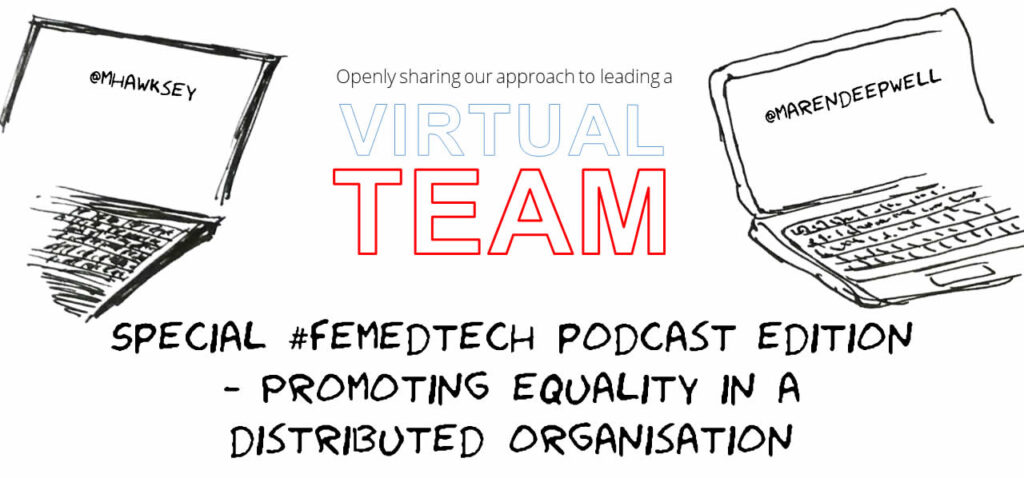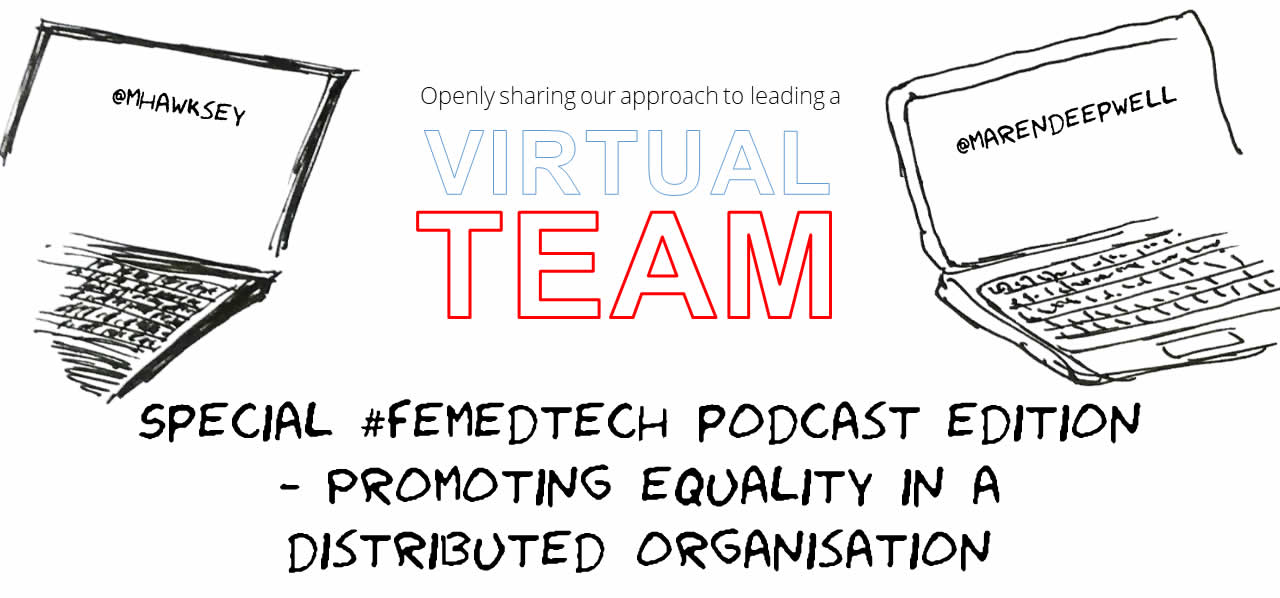
Hello and welcome to this month’s post on leading a virtual team. In this post (cross-posted here) the two of us, that is Martin Hawksey (@mhawksey) and Maren Deepwell (@marendeepwell), continue our series of openly sharing our approach to leadership.
If you are new here, you can catch up on earlier posts and podcasts or find out more about ALT, the organisation we work for as senior staff. We really appreciate comments & feedback and welcome questions or suggestions for future posts.
February
Maren: In the past year we’ve each volunteered as a guest curator for @femedtech (here’s a link to my post on that). Promoting greater equality in Learning Technology and in our distributed organisation in particular has become an important part of our professional practice. In 2017 I gave this talk at EdTech17 and since then I’ve included something about equality in most of my talks, following the example of others to use my voice to raise awareness.
As my turn to volunteer as a guest curator is coming up just after International Women’s Day on 8 March and we are contributing a joint keynote on promoting equality in a distributed organisation to a related event at the University of the Highlands and Islands, I’ve started to reflect on what I’ve learnt over the past year and come up with some ideas to discuss in this post and podcast: first, I’ve discovered lots of my own blind spots – issues and inequalities that I wasn’t aware of previously. The #femedtech network and also working in the Open Education community has helped with that (although there is a lot more to learn). Also, our work on policies for remote working has prompted me to question what I can do, what I can change, to help address any structural inequality within our organisation, by for example reviewing policies for flexible working and family leave. Another thought is that reading the narratives of others, recounting personal journeys, precarious work and family situations, career challenges, work life balance problems and so forth, made me reflect on how far outside of any comfort zone I usually work. And that is a sobering thought, particularly as I am in a position of relative privilege.
Martin: It’s interesting to consider equality and diversity as part of a distributed team. A number of the discussions I’ve seen around gender equality highlight the benefits of employers providing better opportunities for flexible working. Another factor to consider is the physical workplace can be very gender bias. The allocation/distribution of toilets is often mentioned, but I think there are lots of other environmental factors which are often overlooked. I don’t know whether virtual workplaces can be gender bias, perhaps you have thoughts on this, but it’s interesting that in a 2017 survey on Jobsite they reported that 76% of female tech professionals thought businesses offering remote working were more likely to retain top talent. Blind spots is one of the biggest challenges, not just within the workplace, but society as a whole. Before attitudes and approaches can be changed the issue first has to be acknowledged. In the case of gender I think a lot of guys don’t see a problem, or even if they do see it as a problem it is something that they shouldn’t be concerned about. As part of curating #femedtech (trying not to be an arsehole) I came across the “ICTs’ for Feminist Movement Building – Activist Toolkit:
A part of this Frances Bell highlighted the ‘Principles of Feminist Communication’ which is part of the toolkit. A principle that caught my eye was “we produce content in a democratic manner. Women take the lead. The process serves to build positive power”. In the case of @femedtech it is absolutely important that women lead this community, but for it to be successful it has to reach those who have their own blind spots. As such I was grateful for the opportunity to curate this community for a short period. As I explained to a friend the best equality and diversity training I had ever been on.
Maren: I agree. It’s an enormously valuable experience. Physical workspace is an interesting area when it comes to promoting equality and I’d include conference/meeting spaces in that. There are many aspects to this, even the seats you sit on: for example, I was on an all women panel once conducted on a high stage on bar stools. Not great when panelists are wearing skirts and the camera is located five feet below. Or dress codes for work, including it still being legal to stipulate women wear heels. And don’t get me started on the topic of pockets.
Working closely with the tech sector a different kind of stereotype dominates, the genius young start up CEO or coder, mostly males who work all hours of the day. Having other responsibilities outside of work or not being able or willing to give up 100% of your time all of the time can easily be looked down on. If you open up your perspective to challenging discrimination based on age, disability, gender reassignment, race, religion or belief, sex, sexual orientation, marriage and civil partnership, and pregnancy and maternity then the challenges just keep getting bigger (ALT’s policy on equality & diversity underlines this). Which is why I feel so strongly that it’s also a matter of personal responsibility to help promote greater equality: everyone can make a difference within their personal practice, their immediate sphere of influence or even their own mindset. We can each educate ourselves, try and become more aware and raise others’ awareness. I am always inspired by projects such as the Feminist Internet, Women in Red, Uncommon Women and many others that do amazing things. On a related note, I saw a tweet the other day where Kelsey Merkley shared a childhood memory:
It made me smile because my dream jobs growing up were bin man (because of riding at the back of the truck), hot dog vendor (love of ketchup), astronaut (amazing science teacher), judge (inspired by Captain Picard) and my fancy dress costume of choice was Poseidon (trident) and circus director (top hat). It never occurred to me that these weren’t ‘girly’ choices. Nowadays I buy books like Garth Nix’s Frogkisser for the younger readers in my life, so they can develop imaginations in which the White Wizard can be a teenage girl. And I indulge in books like those written by Ursula LeGuin, which have diverse lead characters and cultural contexts so that my own imagination grows in richness and diversity.
Martin: I’m hoping over the generations there is more equality. One issue we have is people just live to darn long so even if this is the case we still have a long time to wait. Just before our last Trustee meeting and knowing I had the prospect of a 4am start I decided to stay up and watch The Great British Sewing Bee. My interest in sewing is largely as a spectator, but I’m quite happy to put buttons back on, I also sewed on all of my daughter’s Brownie badges. People who know me well will recognise me as a maker and DIYer so perhaps not a surprise that I’m interested in this type of programme. When I was a kid I remember one year asking Santa for a sewing machine, I don’t recall it being a particularly positive reaction to that request and think I ended up with a bike instead. As someone with their own child I feel I’m more conscious of not imposing stereotypes. Some of my friends/family are teachers and when we have spoken about this in the past they say they feel there is greater openness and acceptance in areas like sexual orientation in that generation. Thinking about this post and how it relates to equality in the workplace one question I have is there a danger that remote working will be used to allow organisations to have a diverse workforce but also prevent people having full freedom of expression? An example I have in mind is a number of organisations, notably the education sector, now provide employees with the option of branded rainbow-coloured lanyards. This is a very visible support of the LGBT+ community, an act that would have far less public impact for a remote workforce. Do remote workers have the same degree of expression as office based staff?
Maren: That feels like a good jumping off point for the podcast we are recording for this post. There’s so much to unpack. Like many of the issues we discuss in this series this is a topic that touches on very personal, human questions and reaches all the way to formal HR policies, working with diverse stakeholders and keynote speakers and even our organisation’s strategy. I’ve also explored this in my Senior CMALT portfolio to show that this is a key element of my professional practice.
There’s a person on the image below who has green hair, and that’s intentional. Sure, it’s a small thing, but it’s important because of the thought process that went into it. It’s putting values, policies even, into practice in a playful and powerful way.
